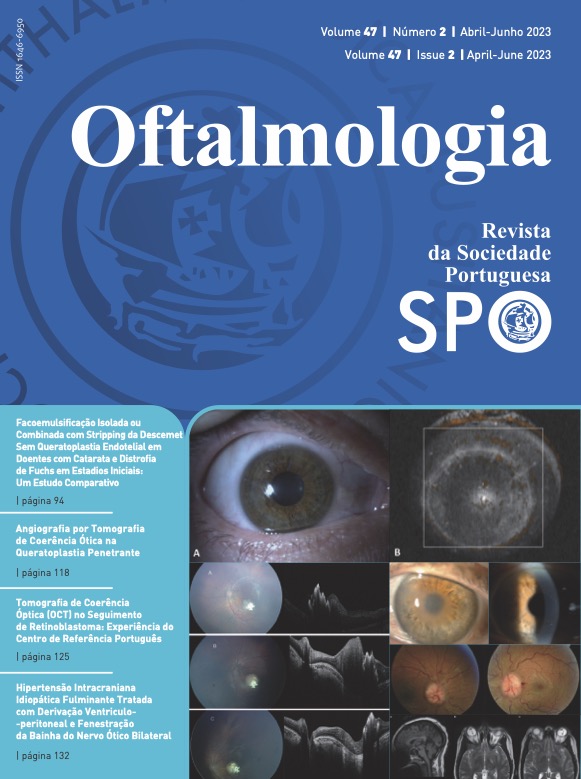Agreement of Vault Size Measurements between the Pentacam®, the Anterion® and the Spectralis®
DOI:
https://doi.org/10.48560/rspo.28273Keywords:
Anterior Chamber, Lens Implantation, IntraocularAbstract
Introduction: Despite good refractive results, implantable collamer lens (ICL) implantation may lead to postoperative complications. One indicator of its safety is the vault size. Our purpose was to evaluate the agreement of vault size measurements between the Pentacam®, the Anterion® and the Spectralis®.
Methods: Cross-sectional analysis of eyes previously submitted to ICL implantation. Vault size was evaluated with the Pentacam® HR, the Anterion® and the Spectralis® (anterior segment). Secondarily, the anterior chamber depth (ACD) was evaluated with the Pentacam® and the Anterion®. Images of the same patient were performed on the same day, by the same technician. Vault and ACD measurements were performed by two refractive surgeons. Images were randomly divided into three groups and each group was analyzed one week apart, by each observer, with images in a randomized order.
Results: Fifty-five eyes (30 patients) were included. The intraclass correlation coefficient (ICC) for absolute agreement and consistency of vault measurements was good to excellent. The vault measurements obtained with Pentacam® were inferior to those obtained with the Anterion® and the Spectralis® (p<0.001). There were no differences between the Anterion® and the Spectralis® (p>0.697). The differences in the vault measurements between the Anterion® and the Pentacam® correlated positively with the increase of the vault size in the Anterion® (p<0.001) and the differences between the Spectralis® and the Pentacam® correlated positively with the increase of the vault size in the Spectralis® (p<0.001). The difference in vault measurements between the Anterion® and the Pentacam® correlated positively with the increase of the pupillary diameter in the Anterion® (p<0.006) and the difference between the Spectralis® and the Pentacam® correlated with the increase of the pupillary diameter in the Spectralis® (p<0.014). For ACD, the ICC for absolute agreement and for consistency between the Pentacam® and the Anterion® was good. Pentacam® provided inferior ACD sizes, compared to the Anterion® (p<0.001).
Conclusion: While the Anterion® and the Spectralis® may be used interchangeably, Pentacam® provided inferior values to those obtained with the other devices. The differences in vault size between devices are influenced by the vault size and the pupillary diameter measured with the Spectralis® and the Anterion®.
Downloads
References
Montés‐Micó R, Ruiz‐Mesa R, Rodríguez‐Prats JL, Tañá‐Rivero P. Posterior‐chamber phakic implantable collamer lenses with a central port: a review. Acta Ophthalmol. 2021;99:e288-e301. doi:10.1111/aos.14599
Sanders DR, Vukich JA. Incidence of lens opacities and clinically significant cataracts with the implantable contact lens: comparison of two lens designs. J Refract Surg. 2002;18:673-82. doi:10.3928/1081-597X-20021101-03
Yang W, Zhao J, Sun L, Zhao J, Niu L, Wang X, et al. Four-year observation of the changes in corneal endothelium cell density and correlated factors after Implantable Collamer Lens V4c implantation. Br J Ophthalmol. 2021;105:625-30. doi:10.1136/bjophthalmol-2020-316144
Owaidhah O, Al-Ghadeer H. Bilateral cataract development and pupillary block glaucoma following Implantable Collamer Lens. J Curr Glaucoma Pract. 2021;15:91-5. doi:10.5005/jp-journals-10078-1309
Ye C, Patel CK, Momont AC, Liu Y. Advanced pigment dispersion glaucoma secondary to phakic Intraocular Collamer Lens implant. Am J Ophthalmol Case Rep. 2018;10:65-7. doi:10.1016/j.ajoc.2018.01.046
Lackner B, Pieh S, Schmidinger G, Simader C, Franz C, Dejaco-Ruhswurm I, et al. Long-term results of implantation of phakic posterior chamber intraocular lenses. J Cataract Refract Surg. 2004;30:2269-76. doi:10.1016/j.jcrs.2004.07.018
Cerpa Manito S, Sánchez Trancón A, Torrado Sierra O, Baptista AM, Serra PM. Biometric and ICL-related risk factors associated to sub-optimal vaults in eyes implanted with Implantable Collamer Lenses. Eye Vis. 2021;8:26. doi:10.1186/s40662-021-00250-6
Kato S, Shimizu K, Igarashi A. Assessment of low-vault cases with an implantable collamer lens. Kobashi H, ed. PLOS ONE. 2020;15:e0241814. doi:10.1371/journal.pone.0241814
Gonvers M, Bornet C, Othenin-Girard P. Implantable contact lens for moderate to high myopia: Relationship of vaulting to cataract formation. J Cataract Refract Surg. 2003;29:918-24. doi:10.1016/S0886-3350(03)00065-8
Fernández-Vigo JI, Macarro-Merino A, Fernández-Vigo C, Fernández-Vigo JÁ, Martínez-de-la-Casa JM, Fernández-Pérez C, et al. Effects of Implantable Collamer Lens V4c Placement on Iridocorneal Angle Measurements by Fourier-Domain Optical Coherence Tomography. Am J Ophthalmol. 2016;162:43-52.e1. doi:10.1016/j.ajo.2015.11.010
Shimizu K, Kamiya K, Igarashi A, Kobashi H. Long-term comparison of posterior chamber phakic intraocular lens with and without a central hole (hole ICL and conventional ICL) implantation for moderate to high myopia and myopic astigmatism: consort-compliant article. Medicine. 2016;95:e3270. doi:10.1097/MD.0000000000003270
Wan T, Yin H, Yang Y, Wu F, Wu Z, Yang Y. Comparative study of anterior segment measurements using 3 different instruments in myopic patients after ICL implantation. BMC Ophthalmol. 2019;19:182. doi:10.1186/s12886-019-1194-y
Almorín-Fernández-Vigo I, Sánchez-Guillén I, Fernández-Vigo JI, De-Pablo-Gómez-de-Liaño L, Kudsieh B, Fernández-Vigo JÁ, et al. Agreement between optical coherence and Scheimpflug tomography: Vault measurements and reproducibility after Implantable Collamer Lens implantation. J Fr Ophtalmol. 2021;44:1370-80. doi:10.1016/j.jfo.2021.03.007
Koo TK, Li MY. A guideline of selecting and reporting intraclass correlation coefficients for reliability research. J Chiropr Med. 2016;15:155-63. doi:10.1016/j.jcm.2016.02.012
Li X, Zhou Y, Young CA, Chen A, Jin G, Zheng D. Comparison of a new anterior segment optical coherence tomography and Oculus Pentacam for measurement of anterior chamber depth and corneal thickness. Ann Transl Med. 2020;8:857-7. doi:10.21037/atm-20-187
Wang Q, Ding X, Savini G, Chen H, Feng Y, Pan C, et al. Anterior chamber depth measurements using Scheimpflug imaging and optical coherence tomography: Repeatability, reproducibility, and agreement. J Cataract Refract Surg. 2015;41:178-85. doi:10.1016/j.jcrs.2014.04.038
O’Donnell C, Hartwig A, Radhakrishnan H. Comparison of central corneal thickness and anterior chamber depth measured using LenStar LS900, Pentacam, and Visante AS-OCT. Cornea. 2012;31:983-8. doi:10.1097/ICO.0b013e31823f8e2f
Pardeshi AA, Song AE, Lazkani N, Xie X, Huang A, Xu BY. Intradevice repeatability and interdevice agreement of ocular biometric measurements: a comparison of two swept-source anterior segment OCT devices. Transl Vis Sci Technol. 2020;9:14. doi:10.1167/tvst.9.9.14
Cheng SM, Zhang JS, Li TT, Wu ZT, Wang P, Yu AY. Repeatability and agreement of two swept-source optical coherence tomographers for anterior segment parameter measurements. J Glaucoma. 2022;31:602-8. doi:10.1097/IJG.0000000000001989
Tañá-Rivero P, Rodríguez-Carrillo MD, Ruíz-Santos M, García-Tomás B, Montés-Micó R. Agreement between angle-to-angle distance and aqueous depth obtained with two different optical coherence tomographers and a Scheimpflug camera. J Refract Surg. 2021;37:133-40. doi:10.3928/1081597X-20201013-01
Doors M, Cruysberg LP, Berendschot TT, de Brabander J, Verbakel F, Webers CA, et al. Comparison of central corneal thickness and anterior chamber depth measurements using three imaging technologies in normal eyes and after phakic intraocular lens implantation. Graefes Arch Clin Exp Ophthalmol. 2009;247:1139-46. doi:10.1007/s00417-009-1086-6
Downloads
Published
How to Cite
Issue
Section
License
Copyright (c) 2023 Revista Sociedade Portuguesa de Oftalmologia

This work is licensed under a Creative Commons Attribution-NonCommercial 4.0 International License.
Do not forget to download the Authorship responsibility statement/Authorization for Publication and Conflict of Interest.
The article can only be submitted with these two documents.
To obtain the Authorship responsibility statement/Authorization for Publication file, click here.
To obtain the Conflict of Interest file (ICMJE template), click here





